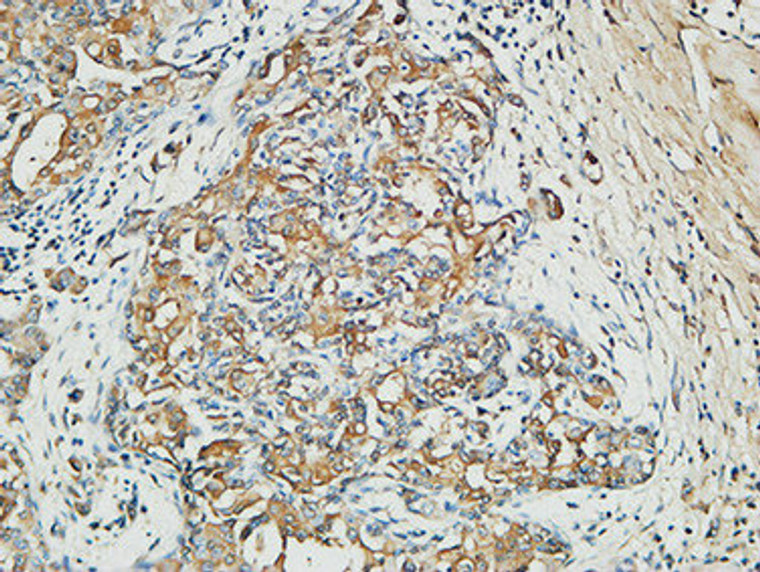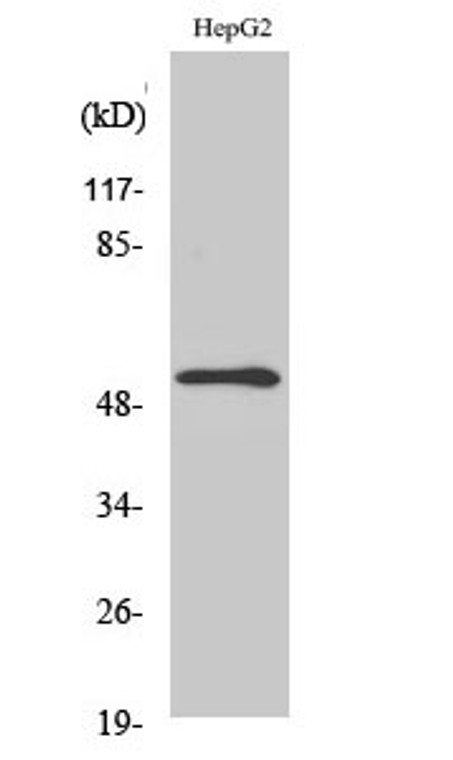-
Western blot analysis of lysates from LOVO cells, using MMP-13 Antibody. The lane on the right is blocked with the synthesized peptide.
-
Immunofluorescence analysis of HepG2 cells, using MMP-13 Antibody. The picture on the right is blocked with the synthesized peptide.
-
Immunohistochemistry analysis of paraffin-embedded human breast carcinoma tissue, using MMP-13 Antibody. The picture on the right is blocked with the synthesized peptide.
-
Immunohistochemical analysis of paraffin-embedded Human Mammary cancer. 1, Antibody was diluted at 1:200 (4°C overnight). 2, High-pressure and temperature EDTA, pH8.0 was used for antigen retrieval. 3, Secondary antibody was diluted at 1:200 (room temperature, 30min).
-
Immunohistochemical analysis of paraffin-embedded Human Mammary cancer. 1, Antibody was diluted at 1:200 (4°C overnight). 2, High-pressure and temperature EDTA, pH8.0 was used for antigen retrieval. 3, Secondary antibody was diluted at 1:200 (room temperature, 30min).
-
Immunohistochemical analysis of paraffin-embedded Human Colon cancer. 1, Antibody was diluted at 1:100 (4°C overnight). 2, High-pressure and temperature EDTA, pH8.0 was used for antigen retrieval. 3, Secondary antibody was diluted at 1:200 (room temperature, 30min).
-
Immunohistochemical analysis of paraffin-embedded Human Mammary cancer. 1, Antibody was diluted at 1:200 (4°C overnight). 2, High-pressure and temperature EDTA, pH8.0 was used for antigen retrieval. 3, Secondary antibody was diluted at 1:200 (room temperature, 30min).
-
Immunohistochemical analysis of paraffin-embedded Human Colon cancer. 1, Antibody was diluted at 1:100 (4°C overnight). 2, High-pressure and temperature EDTA, pH8.0 was used for antigen retrieval. 3, Secondary antibody was diluted at 1:200 (room temperature, 30min).
-
Immunohistochemical analysis of paraffin-embedded Human Colon cancer. 1, Antibody was diluted at 1:100 (4°C overnight). 2, High-pressure and temperature EDTA, pH8.0 was used for antigen retrieval. 3, Secondary antibody was diluted at 1:200 (room temperature, 30min).
-
Western blot analysis of mouse-brain lysis using MMP-13 antibody. Antibody was diluted at 1:500
-
Western blot analysis of various cells using MMP-13 Polyclonal Antibody diluted at 1:500
-
Immunofluorescence analysis of Hela cell. 1, MMP-13 Polyclonal Antibody (green) was diluted at 1:200 (4°C overnight). 2, Goat Anti Rabbit Alexa Fluor 488 Catalog: (NA was diluted at 1:1000 (room temperature, 50min). 3 DAPI (blue) 10min.


















![Immunofluorescence analysis of MCF7 cells using [KO Validated] MMP13 Rabbit polyclonal antibody (STJ119232) at dilution of 1:100 (40x lens). Secondary antibody: Cy3 Goat Anti-Rabbit IgG (H+L) at 1:500 dilution. Blue: DAPI for nuclear staining. Immunofluorescence analysis of MCF7 cells using [KO Validated] MMP13 Rabbit polyclonal antibody (STJ119232) at dilution of 1:100 (40x lens). Secondary antibody: Cy3 Goat Anti-Rabbit IgG (H+L) at 1:500 dilution. Blue: DAPI for nuclear staining.](https://cdn11.bigcommerce.com/s-zso2xnchw9/images/stencil/300x300/products/98104/381734/STJ119232_1__37752.1713149924.jpg?c=1)